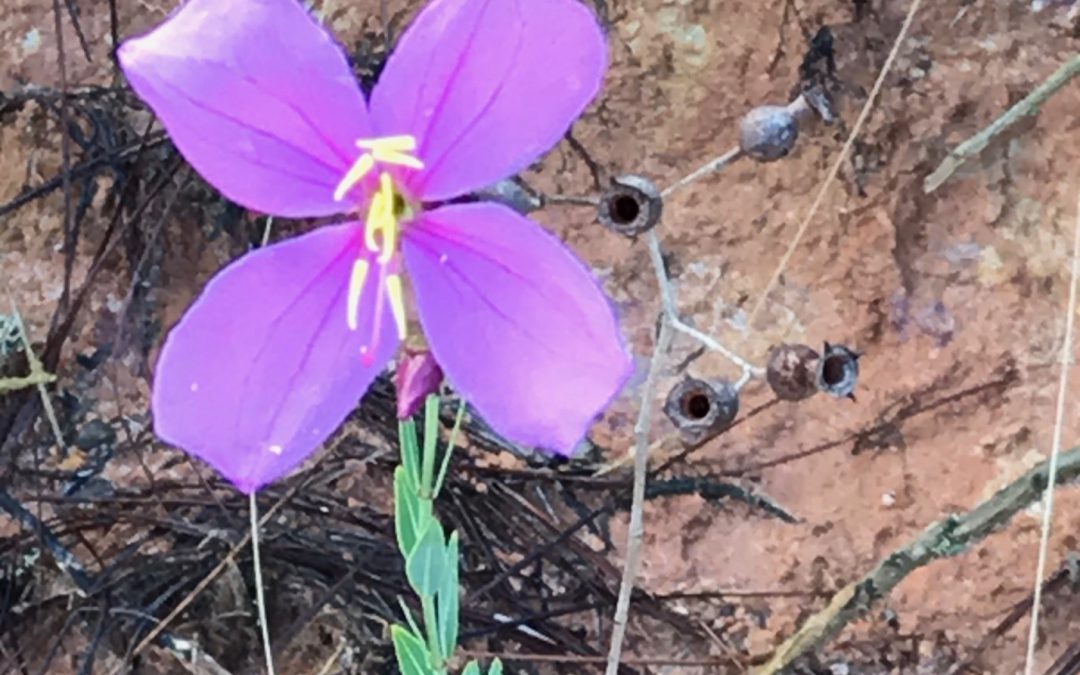
by Sheila Dunning | Jul 9, 2021

Photo by: Sheila Dunning
Have you noticed the beautiful pink flowers in the meadows near the woods? That’s what many early explorers of Florida may have said, which lead to the common name of Rhexia spp. Meadow beauty (Rhexia spp.) is a Florida native found in mainly moist habitats, including flatwoods, wet meadows, marshes and savannas. Rhexia species are herbaceous perennials that flowers from late spring to fall, going dormant in winter. The simple leaves are simple and oppositely arranged. The flower has four petals, four sepals and eight long, bright orange-yellow stamen with curving anthers on the end. The light pink flowers face outward on a 1-2 feet tall stack, each one measuring about an inch across. The unique shape of the stamen and anthers suggests that the Rhexia species are buzz pollinated.
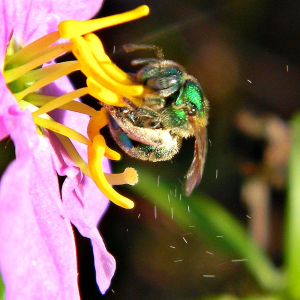
By Bob Peterson from North Palm Beach, Florida, Planet Earth! – Buzz Pollination (Sonication), CC BY-SA 2.0, https://commons.wikimedia.org/w/index.php?curid=38199019
Buzz pollination or sonication is a technique used by some bees to release pollen which is firmly held by the anthers. The anthers of buzz-pollinated plant species are typically tubular, with an opening at only one end, and the pollen inside is smooth-grained and firmly attached. In order to release the pollen, the bees grab onto the flower and move their flight muscles rapidly, causing the flower and anthers to vibrate, dislodging pollen. Honeybees cannot perform buzz pollination. Only about 9% of the flowers in the world are primarily pollinated using buzz pollination. So, meadow beauty is not just pretty, it has a unique connection with native bees.
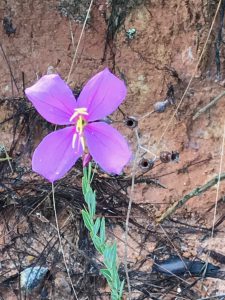
Photo by: Sheila Dunning
Meadow beauty grows in full sun or partial shade. The plant can reproduce by seeds and underground rhizomes. Rhexia spp. are also a tasty treat for deer as they graze in the meadow. The flowers don’t last long and can’t handle being touched. In Greek, Rhexia means “breaks”. So, enjoy them as you walk through the woods, but leave them for the bees rather than picking them.

by Daniel J. Leonard | Nov 18, 2020
The native Florida landscape definitely isn’t known for its fall foliage. But as you might have noticed, there is one species that reliably turns shades of red, orange, yellow and sometimes purple, it also unfortunately happens to be one of the most significant pest plant species in North America, the highly invasive Chinese Tallow or Popcorn Tree (Triadica sebifera).
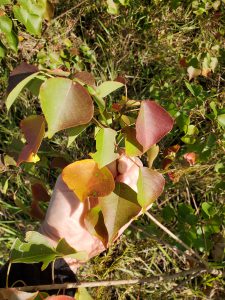
Chinese Tallow fall foliage. Photo courtesy of Daniel Leonard.
Native to temperate areas of China and introduced into the United States by Benjamin Franklin (yes, the Founding Father!) in 1776 for its seed oil potential and outstanding ornamental attributes, Chinese Tallow is indeed a pretty tree, possessing a tame smallish stature, attractive bark, excellent fall color and interesting white “popcorn” seeds. In addition, Chinese Tallow’s climate preferences make it right at home in the Panhandle and throughout the Southeast. It requires no fertilizer, is both drought and inundation tolerant, is both sun and shade tolerant, has no serious pests, produce seed preferred by wildlife (birds mostly) and is easy to propagate from seed (a mature
Chinese Tallow tree can produce up to 100,000 seeds annually!). While these characteristics indeed make it an awesome landscape plant and explain it being passed around by early American colonists, they are also the very reasons that make the species is one of the most dangerous invasives – it can take over any site, anywhere.
While Chinese Tallow can become established almost anywhere, it prefers wet, swampy areas and waste sites. In both settings, the species’ special adaptations allow it a competitive advantage over native species and enable it to eventually choke the native species out altogether.
In low-lying wetlands, Chinese Tallow’s ability to thrive in both extreme wet and droughty conditions enable it to grow more quickly than the native species that tend to flourish in either one period or the other. In river swamps, cypress domes and other hardwood dominated areas, Chinese Tallow’s unique ability to easily grow in the densely shaded understory allows it to reach into the canopy and establish a foothold where other native hardwoods cannot. It is not uncommon anymore to venture into mature swamps and cypress domes and see hundreds or thousands of Chinese Tallow seedlings taking over the forest understory and encroaching on larger native tree species. Finally, in waste areas, i.e. areas that have been recently harvested of trees, where a building used to be, or even an abandoned field, Chinese Tallow, with its quick germinating, precocious nature, rapidly takes over and then spreads into adjacent woodlots and natural areas.
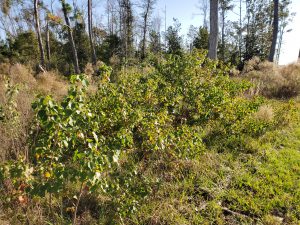
Chinese tallow seedlings colonizing a “waste” area. Photo courtesy of Daniel Leonard.
Hopefully, we’ve established that Chinese Tallow is a species that you don’t want on your property and has no place in either landscapes or natural areas. The question now is, how does one control Chinese Tallow?
- Prevention is obviously the first option. NEVER purposely plant Chinese Tallow and do not distribute the seed, even as decorations, as they are sometimes used.
- The second method is physical removal. Many folks don’t have a Chinese Tallow in their yard, but either their neighbors do, or the natural area next door does. In this situation, about the best one can do is continually pull up the seedlings once they sprout. If a larger specimen in present, cut it down as close to the ground as possible. This will make herbicide application and/or mowing easier.
- The best option in many cases is use of chemical herbicides. Both foliar (spraying green foliage on smaller saplings) and basal bark applications (applying a herbicide/oil mixture all the way around the bottom 15” of the trunk. Useful on larger trees or saplings in areas where it isn’t feasible to spray leaves) are effective. I’ve had good experiences with both methods. For small trees, foliar applications are highly effective and easy. But, if the tree is taller than an average person, use the basal bark method. It is also very effective and much less likely to have negative consequences like off-target herbicide drift and applicator exposure. Finally, when browsing the herbicide aisle garden centers and farm stores, look for products containing the active ingredient Triclopyr, the main chemical in brands like Garlon, Brushtox, and other “brush/tree & stump killers”. Mix at label rates for control.
Despite its attractiveness, Chinese Tallow is an insidious invader that has no place in either landscapes or natural areas. But with a little persistence and a quality control plan, you can rid your property of Chinese Tallow! For more information about invasive plant management and other agricultural topics, please contact your local UF/IFAS Extension office!
References:
Langeland, K.A, and S. F. Enloe. 2018. Natural Area Weeds: Chinese Tallow (Sapium sebiferum L.). Publication #SS-AGR-45. Printer friendly PDF version: https://edis.ifas.ufl.edu/pdffiles/AG/AG14800.pdf
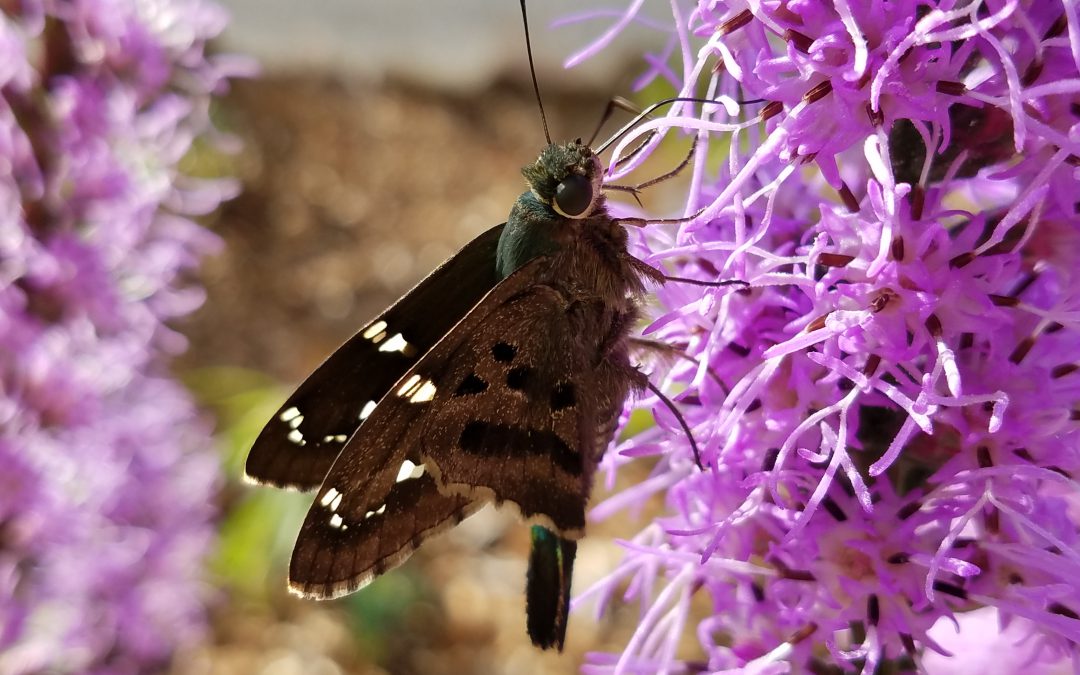
by Evan Anderson | Nov 18, 2020
We don’t always have to look closely or work hard to find beauty in our surroundings. While a well-tended landscape can certainly enhance the aesthetics of an area, there are plenty of places to find naturally attractive plants. With the benefit of being easy to care for, wildflowers are a great option for increasing the appeal of an area not just for people, but for wildlife and pollinators as well.
Not every wildflower is easy to grow or desirable in a landscape. Some have specific requirements that must be met for them to thrive, and some might be too vigorous in their growth. Invasive plants don’t make good neighbors. There are some, however, that have all the right characteristics to make them a solid choice in almost any landscape. Here are four of those that are beautiful, well adapted to the climate and soil in North Florida, and don’t necessarily make pests of themselves.
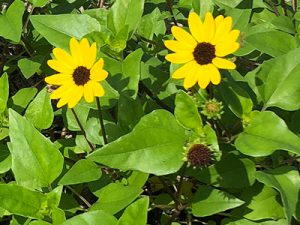
Beach Sunflower
Photo: Evan Anderson
Beach Sunflower
https://edis.ifas.ufl.edu/fp245
Helianthus debilis, also known as beach or dune sunflower, is a perennial in warmer areas, but may die back during the winter in North Florida. Different varieties may sprawl or stand upright, reaching anywhere from one to four feet in height. Blooms may be found on this plant year-round, and even in areas where it is impacted by freezes it will reseed itself.
Beach sunflower prefers a sunny location and are hardy enough to withstand some fairly marginal locations. With good salt and drought tolerance, this plant can be established in an area and left to its own devices. Too much water and fertilizer can be more of a problem for them than too little, though a little of each can help if faster growth is needed. Just be sure to give it enough room, as it likes to spread out, and be ready to trim back old growth every few months to keep plants looking good.
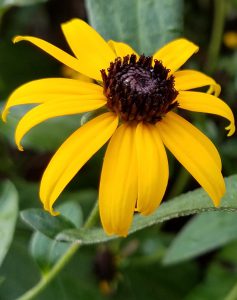
Black-eyed-susan.
Photo: Evan Anderson
Black-eyed Susan
https://edis.ifas.ufl.edu/fp512
Rudbeckia species are often known as Black- or Brown-eyed Susan. Native species and varieties can be found that are well adapted to life in Florida. With their distinctive bright yellow petals surrounding a black or brown center, Black-eyed Susans make great cut flowers and are an attractive addition to landscapes. Generally reaching one to two feet in height and spreading two to three feet, they bloom from spring to fall. Different varieties may be annual, perennial, or biennial.
Preferring full sun (though at least one variety tolerates part shade well) and well-drained soil, Rudbeckia does not mind drought or salt spray. Regular deadheading can help keep these plants looking their best.
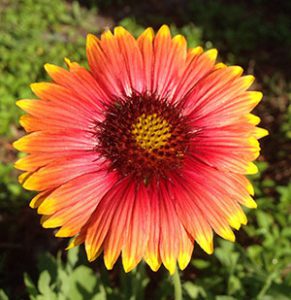
Blanketflower
Photo: Evan Anderson
Blanketflower
https://edis.ifas.ufl.edu/fp216
Gaillardia pulchella is a fiery-looking flower that provides pollinators with nectar and onlookers with a bright pop of color. Growing even in the meanest beach sand, blanketflower blooms from mid-spring to late summer, declining as weather cools. It relies upon its impressive ability to reseed itself to replenish itself each year and can spread rapidly in better soils. Those plants that do persist into cooler weather are in no need of protection, being able to withstand temperatures even into the 20s.
Relatively pest and disease free, plant this wildflower in full sun. It may tolerate some shade, but it will become leggy and creep in search of sun in such places. Dry or well-drained soil is best; certainly avoid over-watering.
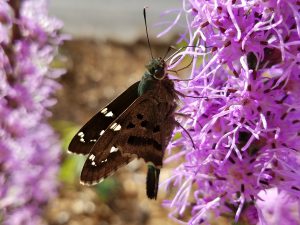
Blazing Star
https://gardeningsolutions.ifas.ufl.edu/plants/ornamentals/liatris.html
There are several species of Liatris native to Florida, any of which can be planted in the panhandle. Tall and showy, the purple blossoms open from the top of the 2-4 foot flower stalk and continue downward. They make great cut flowers and can be placed even in small gardens; while they are tall, they tend not to spread very far. Butterflies, bees, hummingbirds, and other pollinators are attracted to these plants, which tend to bloom in the fall.
Blazing star prefers to be planted in full sun, regardless of species. Well-drained soil is best, though one species, Dense blazing star, does well in moist or wet soils. These flowers do not tend to be firmly rooted, so take care when trimming back dead stems. Consider leaving the stalks alone for a while, even if they aren’t the prettiest things – they will reseed themselves and birds may enjoy making a snack of the seeds.
There are, of course, many more wildflowers out there. These are only a few of the options available. Not all wildflowers are suited to formal landscapes and may be better for informal or naturalized areas. For more information, visit the Florida Wildflower Foundation at https://flawildflowers.org/, the UF/IFAS Florida-Friendly Landscaping™ Program’s Butterfly Gardens mobile web app at https://ffl.ifas.ufl.edu/butterflies/, or the UF/IFAS EDIS publications https://edis.ifas.ufl.edu/topic_wildflowers.
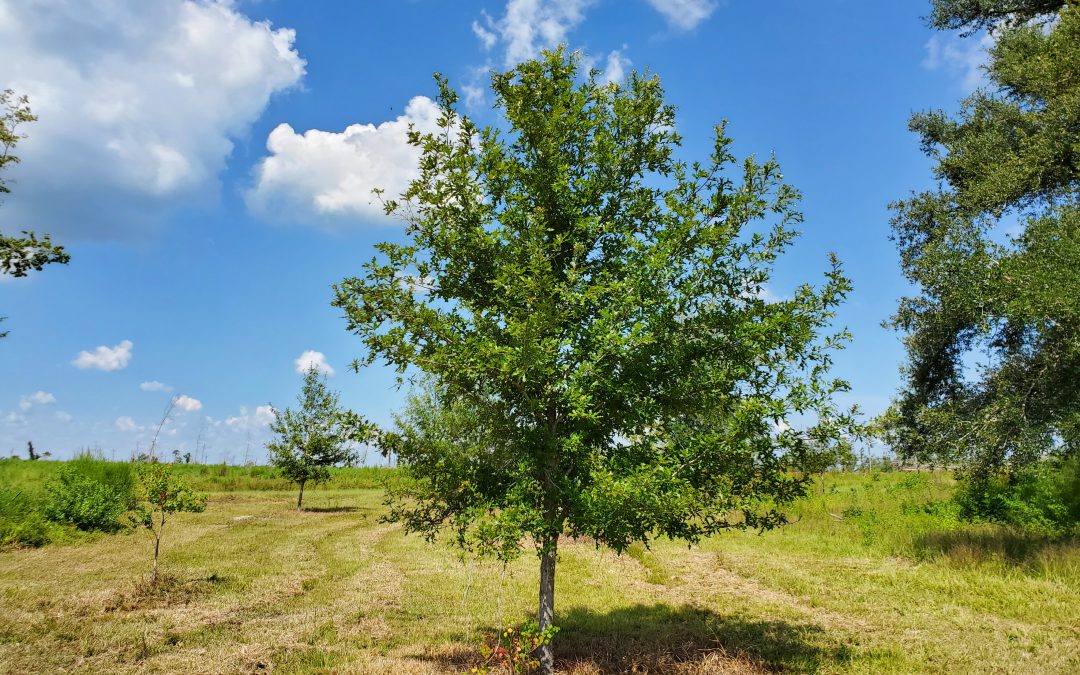
by Daniel J. Leonard | Sep 3, 2020
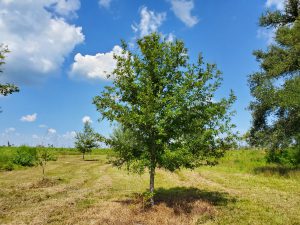
Overcup on the edge of a wet weather pond in Calhoun County. Photo courtesy of Daniel Leonard.
Haunting alluvial river bottoms and creek beds across the Deep South, is a highly unusual oak species, Overcup Oak (Quercus lyrata). Unlike nearly any other oak, and most sane people, Overcups occur deep in alluvial swamps and spend most of their lives with their feet wet. Though the species hides out along water’s edge in secluded swamps, it has nevertheless been discovered by the horticultural industry and is becoming one of the favorite species of landscape designers and nurserymen around the South. The reasons for Overcup’s rise are numerous, let’s dive into them.
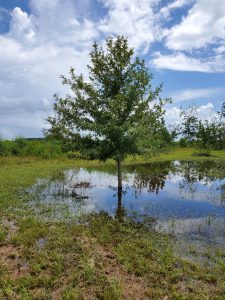
The same Overcup Oak thriving under inundation conditions 2 weeks after a heavy rain. Photo courtesy Daniel Leonard.
First, much of the deep South, especially in the Coastal Plain, is dominated by poorly drained flatwoods soils cut through by river systems and dotted with cypress and blackgum ponds. These conditions call for landscape plants that can handle hot, humid air, excess rainfall, and even periodic inundation (standing water). It stands to reason our best tree options for these areas, Sycamore, Bald Cypress, Red Maple, and others, occur naturally in swamps that mimic these conditions. Overcup Oak is one of these hardy species. It goes above and beyond being able to handle a squishy lawn, and is often found inundated for weeks at a time by more than 20’ of water during the spring floods our river systems experience. The species has even developed an interested adaptation to allow populations to thrive in flooded seasons. Their acorns, preferred food of many waterfowl, are almost totally covered by a buoyant acorn cap, allowing seeds to float downstream until they hit dry land, thus ensuring the species survives and spreads. While it will not survive perpetual inundation like Cypress and Blackgum, if you have a periodically damp area in your lawn where other species struggle, Overcup will shine.
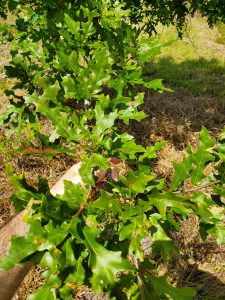
Overcup Oak leaves in August. Note the characteristic “lyre” shape. Photo courtesy Daniel Leonard.
Overcup Oak is also an exceedingly attractive tree. In youth, the species is extremely uniform, with a straight, stout trunk and rounded “lollipop” canopy. This regular habit is maintained into adulthood, where it becomes a stately tree with a distinctly upturned branching habit, lending itself well to mowers and other traffic underneath without having to worry about hitting low-hanging branches. The large, lustrous green leaves are lyre-shaped if you use your imagination (hence the name, Quercus lyrata) and turn a not-unattractive yellowish brown in fall. Overcups especially shine in the winter when the whitish gray shaggy bark takes center stage. The bark is very reminiscent of White Oak or Shagbark Hickory and is exceedingly pretty relative to other landscape trees that can be successfully grown here.
Finally, Overcup Oak is among the easiest to grow landscape trees. We have already discussed its ability to tolerate wet soils and our blazing heat and humidity, but Overcups can also tolerate periodic drought, partial shade, and nearly any soil pH. They are long-lived trees and have no known serious pest or disease problems. They transplant easily from standard nursery containers or dug from a field (if it’s a larger specimen), making establishment in the landscape an easy task. In the establishment phase, defined as the first year or two after transplanting, young transplanted Overcups require only a weekly rain or irrigation event of around 1” (wetter areas may not require any supplemental irrigation) and bi-annual applications of a general purpose fertilizer, 10-10-10 or similar. After that, they are generally on their own without any help!
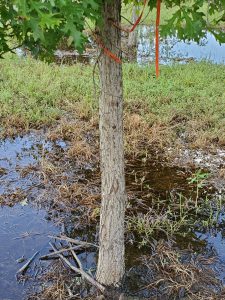
Typical shaggy bark on 7 year old Overcup Oak. Photo courtesy Daniel Leonard.
If you’ve been looking for an attractive, low-maintenance tree for a pond bank or just generally wet area in your lawn or property, Overcup Oak might be your answer. For more information on Overcup Oak, other landscape trees and native plants, give your local UF/IFAS County Extension office a call!
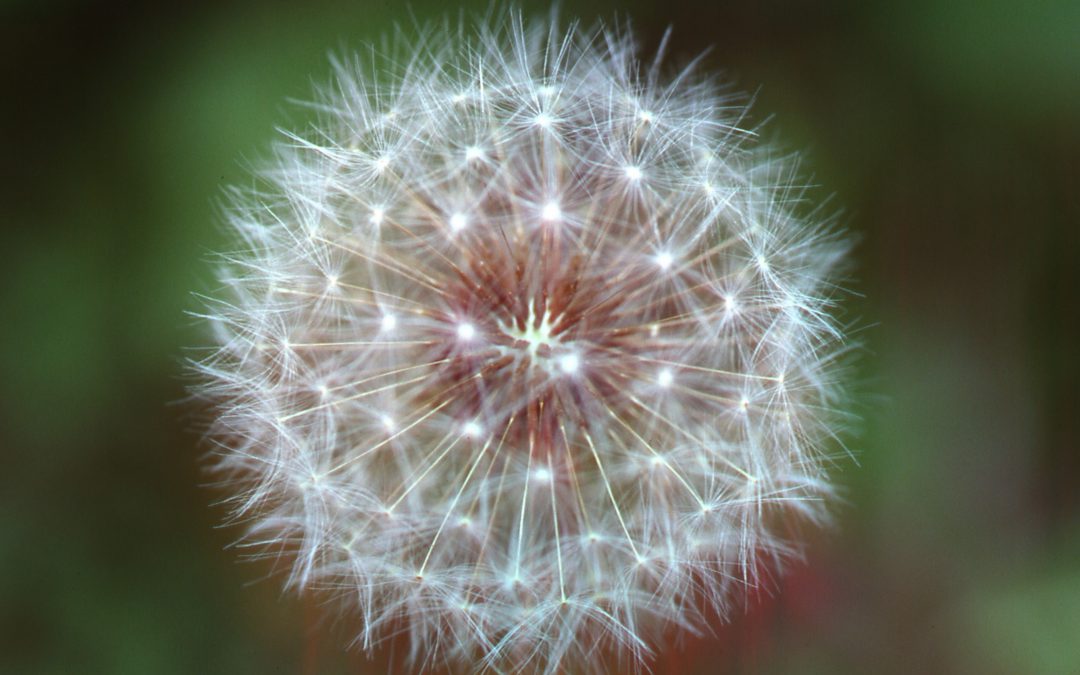
by Molly Jameson | Aug 21, 2020
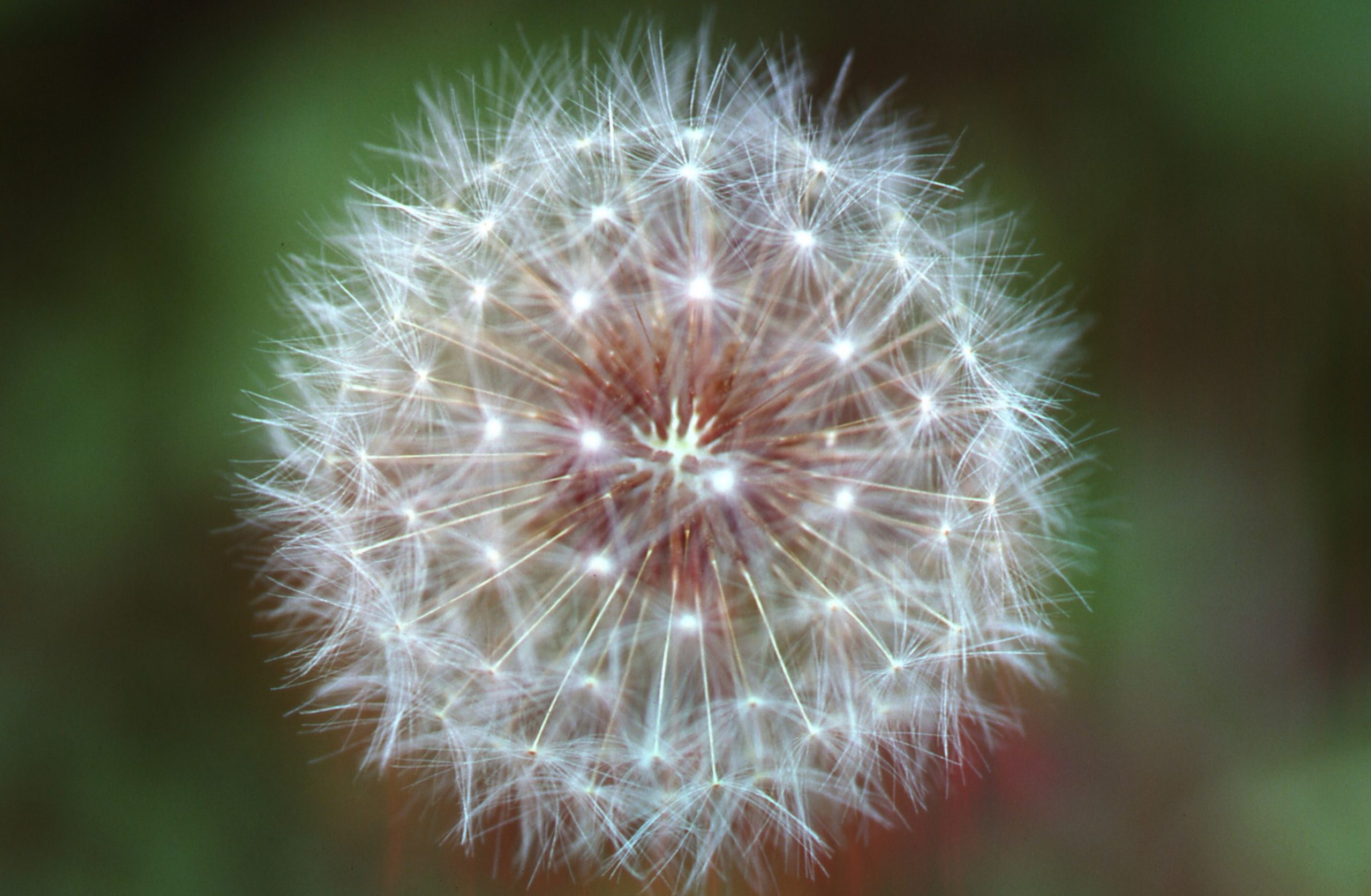
Dandelions form “blow balls” to disperse seeds by wind. Photo by Joseph OBrien, USDA Forest Service, Bugwood.org.
A Second Look at Dandelions
Many of us have memories of spotting a dandelion as a child and immediately gravitating toward it, eager to hold it up by the stem and blow with all our might. If all the puffs of white disappeared, we were sure the dandelion would grant us our wish.
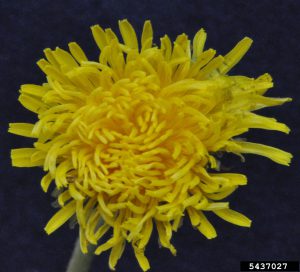
Dandelion flowers, leaves, and roots are all edible and contain many vitamins, minerals, and antioxidants. Photo by Bruce Ackley, The Ohio State University, Bugwood.org.
As an adult, spotting a dandelion may still remind you of the good ole days, but when they begin to encroach upon your lawn or garden, they are likely to be seen less as a friend and more as a foe.
Perhaps the reason they give landscapers headaches is because dandelions thrive in many conditions. They have the ability to grow in the sun and in the shade, and they do well in both disturbed and undisturbed soils. Once more, they thrive in moist environments, and because they are perennials capable of developing long taproots, they also do well in dry environments. A dandelion taproot can grow as deep as three feet in search of water.
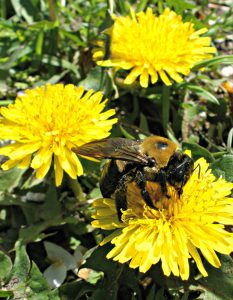
Dandelions are an important early season nectar and pollen source for bees, such as for this carpenter bee. Photo by Ansel Oommen, Bugwood.org.
Although the common dandelion (Taraxacum officinale) is native to Eurasia, it is naturalized to North America and is believed to have arrived with European settlers in the 1600s. At first glance, you may wonder why colonists bothered to transport such a small yellow flower so far. As it turns out, dandelion flowers, leaves, and taproots are all edible, serving as great sources of fiber and vitamins A, C, and K. Additionally, they are a source of antioxidants, such as beta-carotene, and minerals such as iron, calcium, potassium, and magnesium. Coupled with their ability to thrive in many conditions, you can see why dandelions made a great edition to colonial herb gardens.
Since their arrival in North America, dandelions have become an important early season nectar and pollen source for bees, and they help support both the larval and mature stages of some species of butterflies and moths. Additionally, dandelions can be a food source for wildlife, such as white-tailed deer, quail, wild turkeys, and rabbits.
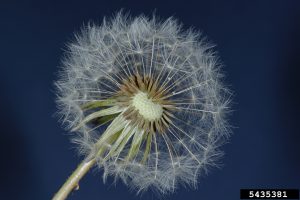
A single dandelion “flower” can have more than 100 florets that each develop into a seed-like fruit that has a parachute-like pappus that can carry the seed up to five miles away. Photo by Joseph Berger, Bugwood.org.
A member of the Aster family, dandelions are related to lettuce, artichokes, and sunflowers. When you look at a dandelion flower, you are actually seeing many, many tiny flowers, called florets. A single dandelion “flower” can have more than 100 florets that open in the morning and typically close at night. After a few days, the florets remain closed and each develops a seed-like fruit atop a hollow flower stalk. As the seeds mature, the flower stalk elongates up to two feet high and a tall standing “blow ball” forms. Each ball is comprised of many seeds, each attached to a tuft of bristles, or pappus, that can use the wind to parachute the seed up to five miles away.
So next time you notice a patch of dandelions standing tall on the landscape, put down your herbicide and take a closer look. Observe the visits from hungry bees and butterflies, perhaps pluck some fresh flower petals to add to your morning pancakes, and then pick out your favorite puff of white and make a wish.
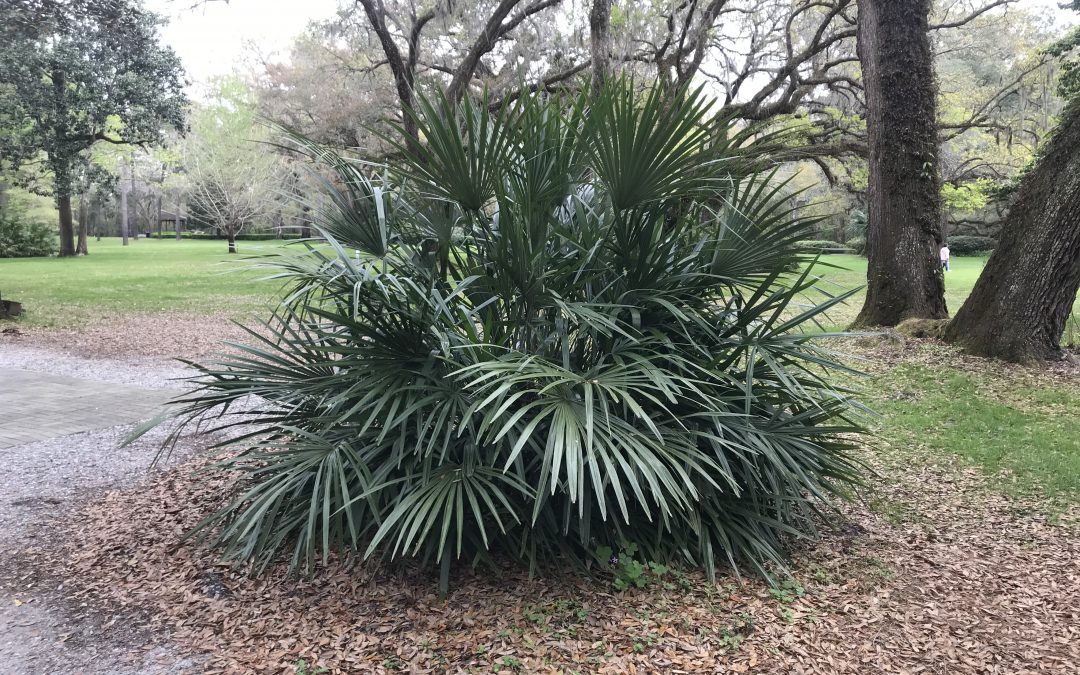
by Daniel J. Leonard | Apr 9, 2020
There aren’t a lot of quality landscape plant options that fit the description nearly every homeowner desires: native, low-maintenance, slow-growing, pest free, drought tolerant while tolerating wet soils, loving both sun or shade, and green year-round. Needle Palm (Rhapidophyllum hystrix) is the rare plant that checks all those boxes and deserves consideration when adding plants to your landscape!
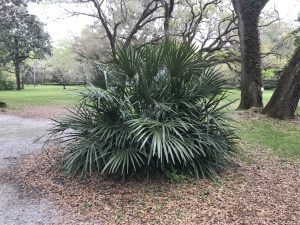
Mature Need Palm at Eden Gardens State Park in Walton County. Photo courtesy the author.
Needle Palm is an endangered native, growing in a narrow range in the coastal Southeastern US, Calhoun and Liberty counties included. It is primarily found in the understories of wet wooded areas along slopes, ravines, and bottoms; if you’ve ever hiked the Apalachicola Ravines or Torreya State Park trails, you’ve likely encountered Needle Palm in the wild! Being native is nice, but what makes Needle Palm an outstanding landscape option?
Needle Palm is the prettier, more refined cousin of Saw Palmetto (Serenoa repens), which it is sometimes confused with. Unlike the rambling, aggressive, stiff-leaved palmetto, Needle palm possesses “softer”, finely cut, lustrous evergreen leaves, allowing it to add amazing texture to any landscape. Also, unlike palmetto, it doesn’t need a yearly “cleaning” to prune out brown, dead leaves, rather its leaves persist green and clean for many years! You might not want to reach into the interior of a Needle Palm plant anyway, as generally unseen 6-8” namesake “needles” surround the base of its trunk. Needle Palm grows very slowly, eventually reaching 8’ tall or so, but is more often seen in the 4-6’ range in landscapes. This is absolutely a shrub that will never outgrow its welcome. It is a nearly trunkless palm, almost always appearing as a shrub, though with extreme old age it can begin to look a bit like a small tree with a muted trunk. With outstanding aesthetics and a low-maintenance growth habit, Needle Palm has a place in nearly any landscape.
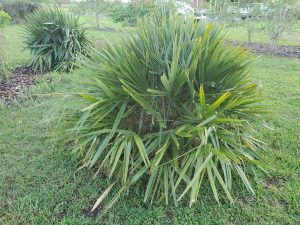
6 year old needle palm grouping growing in author’s landscape.
In the landscape, Needle Palm does best when sited with some shade in the afternoon but also thrives in full sun. They appreciate regular water during establishment but survive on their own without any extra irrigation after! Needle Palm also doesn’t need much in the way of supplemental fertilization. They do look their best with a light spring application of a general purpose, slow-release fertilizer, but this is not required. Needle Palms are not afflicted with the pest and pathogen problems the much more commonly used non-native Sago Palms (Cycas revlolutas) attracts. I’ve grown Needle Palm for 6 years in the landscape and have never noticed any pest or disease issues. With Needle Palms becoming more common in the nursery trade, I don’t see a place in most landscapes for the inferior, high-maintenance, insect infested Sagos. If you want the tropical, textured look of Sagos, plant Needle Palm instead.
Needle Palm is an extremely attractive, low-maintenance Northwest Florida native plant that you should absolutely seek out and add to your landscape! If you want more information or have any questions about Needle Palm or any other landscape/garden topic, please give us a call at the UF/IFAS Calhoun County Extension Office. Happy Gardening!

























